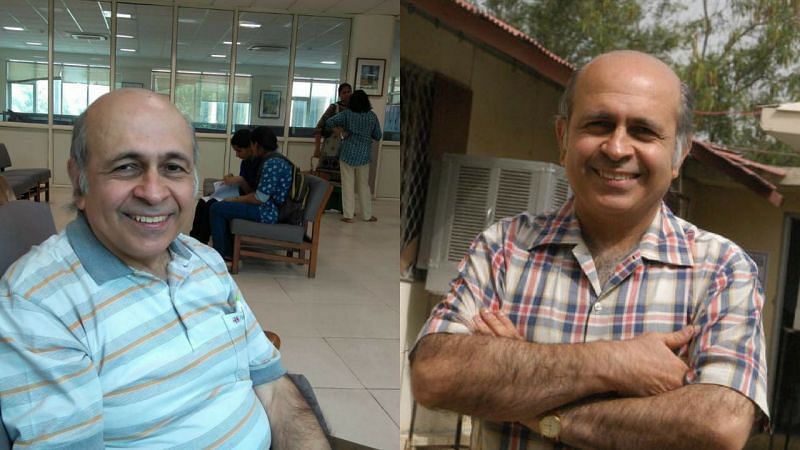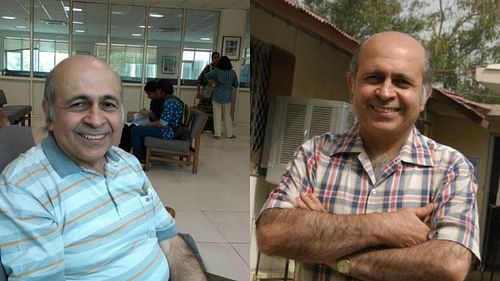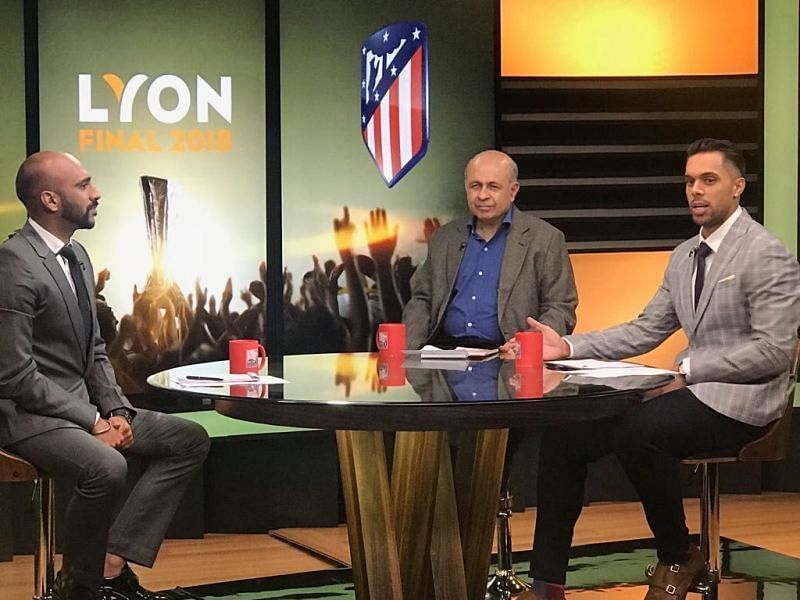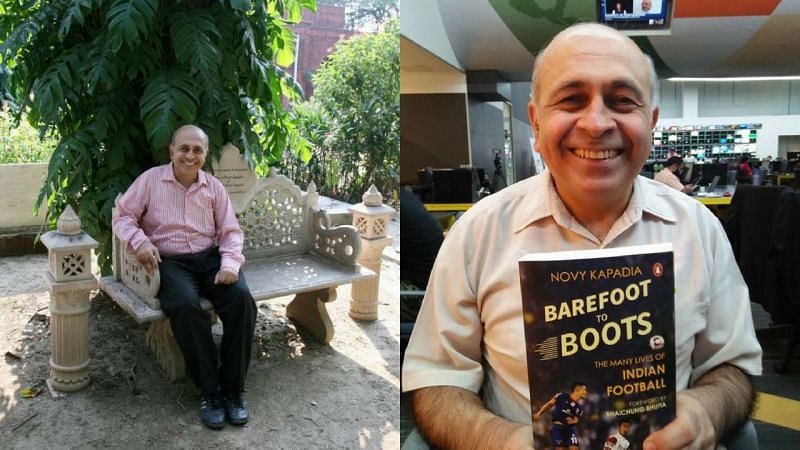
Ahead of FIFA World Cup, Novy Kapadia says 'India also has passionate fans of football and other sports'

"India also has passionate fans of football and other sports. The gallant displays of the Indian team in the FIFA U-17 World cup last year has aroused optimism for the bright future of football in the country, which can be termed as another positive legacy of the country," says Novy Kapadia in this exclusive Interview with Manmohan Harsh.
The Sports fraternity of the entire World is eagerly waiting for the magic of football to unfold in the form of 21st FIFA World Cup, scheduled to commence in Russia in a few days of time. For 32 days, football fever will spread its grip over the billions of fans across the globe and India will be no exception. Although India has never been able to appear in the finals of the most prestigious sports event on Earth, football lovers of the country are going to remain continuously involved in each and every activity of the World Cup.
To discuss the possibilities of teams in FIFA World Cup and passion for this event, who better than Novy Kapadia, former football player, sports journalist, columnist, and commentator. The man has carved a niche for himself through his invaluable contributions to the game and earned the reputation as an authoritative figure in the league of sports enthusiasts and contributors at the core. He has penned down many books on football such as 'Barefoot to Boots', 'The Many Lives of Indian Football,' and 'The Football Fanatic's Essential Guide: 2018 World Cup Special.'
This FIFA World Cup might as well be the farewell edition for Lionel Messi (Argentina), and Cristiano Ronaldo (Portugal), who have the largest fan following across the globe. Novy thinks that team from France is one of the most well balanced and best-suited teams to win and repeat its feat of 1998.
He says the absence of Italy, the four-time winners, and European giant Netherlands will be missed a lot in Russia. Brazil, Uruguay, Russia, Spain, Argentina, Germany, France, Denmark, Croatia, Poland, Switzerland, Sweden, Belgium, Portugal, England, and Columbia will make it to the last sixteen (QF) according to Novy.
In this exclusive interview, Novy also addresses the causes and concerns of the country about the beautiful game and guides the aspiring commentators on how to pursue their dream in the most challenging circumstances. Here are the excerpts:
Q. When Indian football lovers dedicate their love for football during the FIFA World Cup, with the history of India never playing in the final stage, their passion is often termed as 'Begani Shadi Mein Abdulla Deewana' (Getting jubilant in others participation without having any relation or connection). How do you see this link?
In the era of globalization, passion for the greatest show on Earth is inevitable. With European leagues being shown all the year round, Indian fans are familiar with players and get attached to the clubs and then the national teams. Historically, fans in Bengal and Kerala liked either Brazil or Argentina. The standard of World football is so much higher than ours, so people feel involved with different countries.
This is a pattern all over the world. Only five to six nations have a chance of winning the World Cup, so fans all over the world get attached to their favorite country once their country is not in contention. Since the 1990s, when the World Cup was shown on satellite TV in India, with massive promotion and all news channels doing programmes, the craze has peaked. It is continuously growing and also helping a lot in advancement and progress of the game in the country.

Q. In your opinion, what has the FIFA U-17 contributed to Indian football as we played host a few months back to this prestigious event? How do you think it has benefited and will affect the future in due course?
India shattered the record for largest attendance at the U-17 World Cup, with a massive 13,47,143 spectators attending the event. This showed that the country is not just obsessed with cricket and there are passionate fans for other sports as well. The FIFA President Gianni Infantino, who attended the final along with other FIFA executive members, was also suitably impressed and mentioned that the future is football in the nation.
Another positive aspect is that these matches were held in six world-class all-seater stadia, including The Vivekananda Yuba Bharati Krirangan (Salt Lake stadium) in Kolkata, which is also aesthetically pleasing. These stadia can be used to change the outlook about Indian football. Leading European clubs like Real Madrid, Barcelona, Chelsea, Manchester United, and Arsenal can now play in one of the six cities in their pre-season summer tours. These clubs visit Japan, China, Malaysia, and Singapore but can now include India on their list as well because the playing facilities are world class.
For nearly one week, from October 6-12, 2017, the U-17 Indian football team got extensive media coverage. The players became household names and received massive adulation from the fans and ample media exposure. Spectators at the Jawaharlal Nehru stadium, Delhi, chanted the names of their heroes - goalkeeper Dheeraj Moirangthem, Anwar Ali, Boris Thangjam, Jitendra Singh, Komal Thatal and the six-foot-tall goal scorer Jeakson Thounaojam.
The Indian team played gallantly in Group A, against superior oppositions, losing 0-3 to the USA, 1-2 to Colombia and 0-4 to Ghana. However, they did not get overawed and created a positive impression. The gallant displays of the team aroused optimism for the future, which is yet another positive takeback.
Q. Your book on the journey of Indian football was launched by the FIFA president during U-17 World cup in New Delhi, tell us something about what sort of work it contains and the real story it reveals?
My book is a thrilling account of the incredible history of Indian football and its journey from the start of the Durand football tournament in 1888, which is the third oldest in the world after the FA Cup in England, and FA Cup in Scotland.
Only a minority of people are aware that India was once called the ‘Brazil of Asia,’ or that the rivalry between East Bengal and Mohun Bagan is ranked among the top 50 club rivalries in the world. Brilliant players, world-class coaches and passionate fans - including political leaders - once combined to make India a football-worshipping nation.
A major source of sports entertainment, football has thrived in several towns and cities apart from Calcutta. Of course, Calcutta or Kolkata still remains the hub of Indian football, with its passionate fans and clubs with great legacies like Mohun Bagan, East Bengal, and Mohammedan Sporting.
In Part II of my book called 'Battles of Supremacy'; I have a whole chapter entitled 'The Great Rivalry,' tracing the matches between Mohun Bagan and East Bengal from 1925 till 2017. The game was also inextricably linked to community identity and has been shrewdly used towards political ends. Football in India has also contributed richly to our cultural heritage.
In 'Barefoot to Boots', foremost I have used my four decades of experience as a commentator and writer to reveal Indian football’s glorious legacy through riveting descriptions and analysis of on-field action, stories of memorable matches, lively anecdotes, and exclusive conversations with legendary players and officials.
Having experienced many of these transitions first hand, I have traced the eventful journey of the sport up to the present and so the book will enthrall old and new fans alike. It offers invaluable insight into the future of the game as the Indian Super League (ISL) dramatically changes the face of domestic football. India’s image has also improved in World Football after successfully hosting the U-17 World Cup for the first time and breaking the overall attendance record for the tournament.
I am very proud of the 16 pages of rare photographs that have been used, which took me over two months to collect from newspaper archives and old players from all over India. The book has black and white photographs of Mohun Bagan’s 1911 IFA Shield win, and several old newspaper clippings of India’s gold medal triumph in the 1962 Jakarta Asian Games, participation in the 1948, 1956 and 1960 Olympics, and the match report from the Statesman of the first ever Mohun Bagan vs East Bengal clash in 1925.

Q. You are a veteran of many battles as far as the contributions to the sports fraternity go, through commentary and other modes as critic, writer, and journalism. From where do you get so much of passion and motivation to serve the sports?
Sports is my passion in life. Since childhood, I have been reading a lot about sports. Even during my playing days I always read a lot about different sports from newspapers and old magazines.
I enjoyed collecting data and compiling old records, so I always have a good database of any sport I cover. I enjoy watching sports, especially football and it is an added bonus to be able to write and speak about my hobby and passion. My motivation is my love for watching and talking about sports and sharing ideas and insights with others.
Q. What kind of challenges do you feel in front of the commentators like you in this digital age? What changes did you have to make - as you have travelled a long way from the days of radio - to the new broadcasting era where many sports dedicated channels are dominant and riding on the high expectations of the viewers who may switch over the channel at will?
Commentators nowadays cannot only rely on voice, identification of players, and description of the action. A commentator has to be an expert, provide extra information, give historical references and comparisons and analyse the match in a proper perspective. Moreover, a contemporary commentator must both educate and entertain.
Q. You have earned distinction with your expertise and have a firm grip over sports as an encyclopedia, with plenty years of experience under the belt. However, nowadays, the trend is such that a celebrity of sports - after calling it a day - directly takes over the commentary box and slowly learns the tricks of the trade, without any real struggle. So what is your take on this celebrity commentary brigade V/S Original Commentators with basics?
The trend of former cricketers becoming commentators after they retire started with Kerry Packer’s Channel 9 in Australia. In India, it took after Satellite TV came to the country and rights went to ESPN-Star Sports.
Descriptive ability is very important so in other sports, this trend is not so noticeable. Former players only work as expert commentators in other sports. The main lead commentator in sports besides cricket is always somebody who is a regular commentator. The advantage of former players is that if they are good thinkers of the game they can analyze techniques very well, share interesting anecdotes and stories of the past.
Q. What is your message to those who wish to become a sports commentator?
Very difficult in India, except in cricket, which is played throughout the year. In other sports, it is best to persist with commentary as a hobby along with a regular job. To work as a full-time sports commentator you have to specialize in several sports, then only you can survive in India.
Follow Sportskeeda for 2018 World Cup Scores, Latest News & Updates, Match Analysis, Detailed Stats, Fantasy Tips, Controversies, Match Predictions and much more.